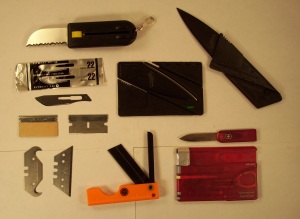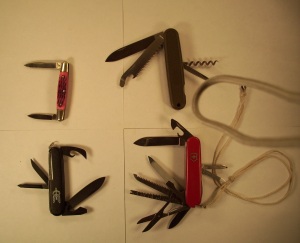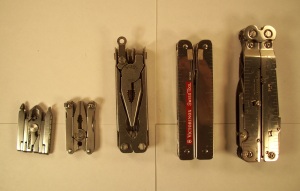In a previous article, we discussed optimal knives for survival and emergency use. These are fairly big and usually carried in a sheath on your belt. This may violate a law, a company policy or just make people nervous which should be THEIR problem, but in today’s environment other people’s problem often can be made to be YOUR problem. Although it is possible to carry such a knife concealed, it is not convenient.
If you are heading out into the ‘wild’ you want the best knife you own with you, no matter what you have to do to avoid authorities and nervous citizens, but if the likely need for a knife is low, there are more convenient options. These are the last 2 of the 5 knife categories we listed in the previous article, folding knives and ‘other’.
A folding knife can actually be a fairly adequate survival blade and yet be convenient for everyday carry in many environments. And handy for everyday activities as well, including cleaning fingernails, scraping stuff off of things, cutting food, sharpening a pencil and opening packages, etc.
A folding knife should have similar characteristics of the ‘Bush’ or ‘medium’ knife described in the previous article, although the blade can and probably should be a bit shorter and possibly even slightly thinner. To find out more about these requirements, see the earlier article (a link is below). To summarize, look for:
– A useful blade shape with a thick, strong point (Drop point is best, Spear point or short, straight clip point is acceptable)
– A bit of belly (the curve between point and straight edge)
– An ability to open (and close) the blade with one hand, with any ‘thumb stud’ small and out of the way (close to the pivot point)
– Ambidextrous opening and closing ability
– A blade length 3 to 4 inches and thickness 1/8″ or close to it
– No serrations, or serrations only in the back inch or so
– A lanyard hole in the grip
– A really good locking mechanism for the blade (a liner lock is often stronger than a lock back)
– A comfortable, durable, non-slip grip which prevents the hand from slipping forward onto the blade
– If carried in the pocket, stainless steel or possibly San Mai steel
UPDATE – My review of a modern San Mai blade found that the center layer is now VG-1, which takes an exceptional edge, but loses it very quickly. As such, I don’t suggest San Mai steel for survival any more, although with a good sharpening system, it can be quite useful for non-critical use.
Good examples include the Doug Ritter RSK Mk1 or Benchmade Gryptilian (price is a bit high, but these are about as appropriate as you can get in a factory blade), CRKT M21 (superior dual lock, but more difficult to close, particularly with the ‘weak’ hand), Spyderco Manix or Stretch or Centofante III, Cold Steel American Lawman (superior lock) or Ka-Bar Dozier Folding Hunter. If these are just a bit too big, many of these have smaller versions available, although the suggested versions don’t really have any blade to spare. Still, a knife you are willing to have with you is far superior to the knife you left behind because it was ‘too big’.
Benchmade Gryptilan (bottom) compared to the Cold Steel Master Hunter (fixed blade)
But let us say that for whatever reason you cannot carry a locking folding knife as described above. This leads us to the ‘other’ category of knives. This class includes ‘everything else’ which can provide you some sort of blade. For the smallest kits, one or two #22 scalpel blades or single edge razor blades or utility knife blades will provide some cutting ability. These have no grip, so are fairly inconvenient to use, but inconvenient is better than none. The scalpel blades are sterile and in sealed packages, which is an advantage for storage and a few uses, and can be lashed to a twig for a handle. The single edge razor blade is a bit stiffer and easier to use ‘as is’, while the utility blade is a bit thicker and thus more durable than the others. A slightly more convenient option is a pocket razor, which is essentially a razor blade which folds into a small grip. Some of these also have a small saw blade in them. An interesting option is the Iain Sinclair CardSharp 2, a fixed blade knife which is decently sized when deployed but when stowed, is exactly the size of a credit card. All of these blades are very thin and thus not for any heavy duty use, but they are wicked sharp so might be of value even if you have a more suitable knife with you.
Some other cutting options:
Top Left: SOG EZ Knife 1 (thin sliding knife with key chain and pocket clip)
Top Right: Iain Sinclair Cardsharp II next to one folded for carrying
Bottom Right: Victorinox Swiss Army Card, available in various versions
Bottom Center: UST Sabercut Razor/Saw
This category can also include locking folding knives or sheath knives much smaller than those discussed already. These tend to have the durability of the bigger knives with the smaller size and less convenient usage of the ‘compact’ types discussed. Still, they are a viable option if they will fit where something ‘better’ will not.
Smaller (6″ or less overall) lockback knives, from top to bottom:
CRKT K.I.S.S., SOG MicroDot, Cold Steel ClipMate
The K.I.S.S. is not only a useable size with compact length, but with a grip panel on only one side, is quite thin as well, making it suitable for smaller kits.
Some compact (7″ or less overall) fixed/sheath knives, from top to bottom:
Ka-Bar/Becker D’Eskabar BK24, Aitor JK II, CRKT RSK MK5, M40 Hybrid Knife/Spearhead
The MK5 is designed to fit into a standard ‘mint tin’ pocket survival kit. The short handle is somewhat compensated for by the lanyard which hooks over the little finger to improve handling.
The BK24 has a fairly useful sized blade, with a skeleton grip which is too short and thin for comfortable usage. Wrapping it in paracord and using the MK5 ‘handle extension’ lanyard technique improves its handling significantly.
The M40 Hybrid (from http://www.m4040.com) is optimized as a spearhead, but has some function as a knife; the grip is fairly small and can be improved by wrapping with a layer of paracord. It is designed to fit into the cookpot of M40’s survival kits. The notches in the grip and the cord wrapping can be used to fasten the spearhead to the shaft.
Photo courtesy of Mike Forti, http://www.m4040.com
Non-locking folding knives should be avoided for survival usage since they are somewhat more dangerous in use than a good locking knife. A couple of possible exceptions would be a pen knife (small, dressy, non-locking folder) if that is all that that your circumstances will allow, or a Swiss Army Knife (SAK). This latter option is quite interesting, as it includes other useful tools in addition to the knife blade or blades. Even better, there are now a few models of SAK which have one hand opening blades which lock open. Victorinox is the originator of the SAK and along with Wenger, are generally the best sources although there are plenty of other ones out there.
Pen knife (upper left) and an assortment of Swiss Army Knives
(Stock photo) Victorinox Trekker One Hand Opening/Locking SAK
With a knife, saw, awl and can opener, as well as screwdrivers, this would be a decent choice for a survival SAK. Add the one hand opening and locking blade, and it might possibly be the most appropriate SAK for survival use. Many of these have a serrated blade; be careful to get the non-serrated blade version, unless this will be a secondary knife and you want the serrations.
Finally, there is a knife blade in a pliers-based ‘multi-tool’, which, like the SAK, offer other tools in addition to the knife blade. These are available in Extra Large, Regular, Compact and Micro versions, from Leatherman, SOG, Gerber, Victorinox and SwissTech as well as a other companies. The advantages of having pliers and wire cutters with you in a survival situation should be obvious, and having other tools as well is even better.
From left to right:
Swiss-Tech Micro-Max and Craftsman micros, SOG Paratool, Victorinox Swisstool and SOG Blacktip
All have at least one knife blade, with the exception of the Swiss-Tool which would not be appropriate for survival usage unless a separate knife is also part of the kit. There are compact ones available, particularly from Gerber, sized between the micro ones and the (standard sized) Paratool.
Related articles
- Knives for Survival and Emergencies (equippedcat.wordpress.com)











